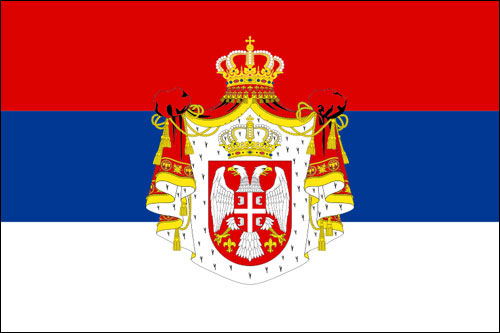Flag

1914 Map
Click on map for more detail
General facts
- Population: 4.5 million (1914)
- Capital: Belgrade (1914 population 90,000)
Government
- Head of State:
- King Petar I (11 June 1903 – 1 December 1918)
- Prince Regent Aleksander Karađorđević (24 June 1914 – 1 December 1918)
Head of Government: Prime Minister Nikola Pašić (12 September 1912 – 1 December 1918)
On 1 December 1918 the Kingdom of Serbia was superseded by the proclamation of a new ‘Kingdom of the Serbs, Croats and Slovenes’ incorporating Serbia, Montenegro and most of the so-called ‘South Slav’ territories of the former Austro-Hungarian Empire. The new kingdom swiftly became better known by its colloquial name, ‘Yugoslavia’ – in English, ‘South Slavia’.
Both King Petar I and Prince Regent Aleksander retained their royal roles and privileges in the new Kingdom.
Pašić continued as interim prime minister until 21 December 1918, when the new kingdom’s first government (22 December 1918 – 16 August 1919) was formed under the leadership of Prime Minister Stojan Protić. Pašić subsequently led the Yugoslav delegation to the Peace Conference at Versailles.
Participation in the War
- Entered the war: 28 July 1914 (Austria-Hungary declared war on Serbia)
- Ceased hostilities: 11 November 1918 (armistice with Germany)
- Ended status as belligerent: 4 June 1920 (Treaty of Trianon between the Allies and the newly-formed Republic of Hungary)
The Treaty of Trianon was signed by the Kingdom of the Serbs, Croats and Slovenes.
Military Forces
Army
- Peacetime strength 1914: 90,000
- Reserves 1914: 420,000
- Mobilised 1914: 530,000
- Total mobilised to October 1915: 710,000
In October 1915 the Central Powers launched their fourth invasion of Serbia. This time the intervention of Bulgaria proved decisive. Faced with certain defeat on their home soil, the Serbian government and high command decided to retreat to the Albanian coast and keep fighting rather than capitulate. At least 300,000 Serb soldiers and refugees attempted to cross the Albanian mountains in the middle of winter. Thousands died.
The survivors, 150,000 soldiers and 20,000 civilians, were evacuated to the Greek island of Corfu by the British and French in December 1915. Eleven thousand Serbs failed to recover from their ordeal and died on Corfu shortly after arriving. After a period of rest and rehabilitation this remnant of the Serbian Army was re-equipped by the French and transported to the Salonika Front, where they served alongside French, British and Italian forces against the Bulgarians and Austrians for the rest of the war.
- Volunteers recruited to Army-in-exile 1916 onwards: 15–20,000
The Serbian Army at Salonika was authorised by the Serbian government-in-exile to accept ethnic Serb or ‘Southern Slav’ volunteers from other Allied nations, notably the United States but also as distant as New Zealand and Australia. They also accepted former Austro-Hungarian prisoners-of-war of Serbian, Croatian, Slovenian and even Czech ethnicity.
Casualties
- Military dead (all causes): 450,000
- Civilian dead: 650,000
Serbia suffered more civilian deaths than military ones in the First World War. This makes Serbia unique amongst all the combatant nations. The reasons are to be found in Serbia’s landlocked location, which isolated it from friendly Allied states and left it at the mercy of the surrounding Central Powers. Serbia was blockaded from the start of the war, and the civilian population suffered badly from famine and disease. The repeated Austrian invasions destroyed much of the north of the country’s infrastructure and farmland. An outbreak of cholera in early 1915 killed 100,000 Serb civilians. Thousands more died alongside the remnants of the Serbian Army during its epic retreat across the Albanian mountains in November–December 1915.
The situation worsened after the conquest of the country by the Central Powers in late 1915. Still more civilians died as Austrian and Bulgarian occupation forces implemented a harsh regime of martial law. Thousands were executed or sent to internment camps and what was left of the country’s industrial and agricultural resources was stripped bare to supply the war economies of the Central Powers. Serbs struck back through guerrilla warfare which led to brutal reprisals from the Austrian and Bulgarian military authorities. This culminated in a mass uprising centred on the Toplica region in February 1917 that at its height drew in 25,000 Austrian, Bulgarian and German troops. An estimated 20,000 Serb civilians were killed or executed in two months by the occupation forces. This cycle of oppression, guerrilla warfare and death through hunger and disease continued to take its toll on the civilian Serb population until the end of the war.
Sources
- Cyril Falls, Military Operations, Macedonia: From the Outbreak of War to the Spring of 1917, HMSO, London, 1933
- Andrej Mitrović, Serbia's Great War 1914–1918, Hurst & Co., London, 2007
- Nigel Thomas and Dusan Babac, Armies in the Balkans 1914–18, Osprey, Oxford, 2001
